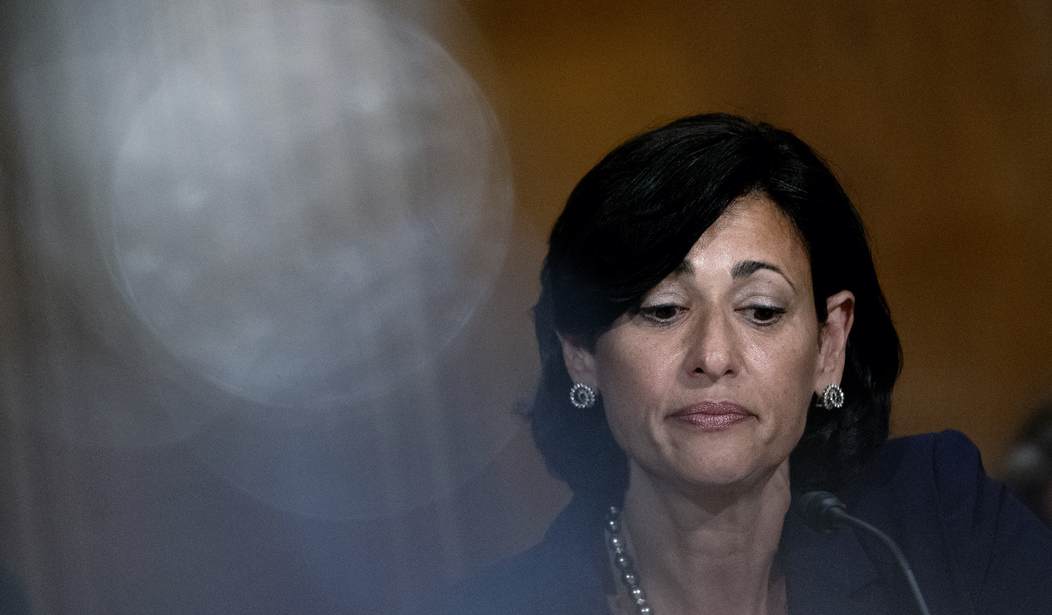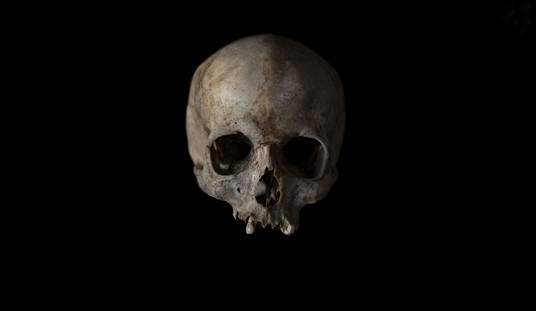Until yesterday, people who tested positive were asked to isolate for 10 days. As of yesterday, people who test positive are asked to isolate for five days and then — if they have no symptoms — to mask up for the next five days if they plan to be around other people. (If you still have symptoms after five days you keep isolating, of course.)
It’s mighty uncharacteristic of our public-health bureaucracy to relax COVID restrictions in the middle of the country’s biggest outbreak of the pandemic. There must be some compelling new data to drive this momentous shift in policy.
Uh, what is it?
“The change is motivated by science demonstrating that the majority of SARS-CoV-2 transmission occurs early in the course of illness, generally in the 1-2 days prior to onset of symptoms and the 2-3 days after,” the CDC said in its notice about the policy change yesterday — without elaborating on what that science is. If I were a cynic, I’d suspect that the “science” here has less to do with new data than with the reality that forcing American workers to quarantine for two weeks at a moment when a gigantic share of the population is infected would bring the economy to its knees.
Which is to say, it sounds like the CDC is letting business considerations drive the “science.”
Don’t take my word for it. Anthony Fauci was unusually frank about the role that keeping workers on the job played in the CDC’s reasoning. Watch the first minute or two here.
"The reason is that with the sheer volume of new cases that we are having and that we expect to continue with Omicron, one of the things we want to be careful of is that we don't have so many people out," Dr. Anthony Fauci explains why CDC changed Covid isolation guidelines. pic.twitter.com/g48XwcDdJh
— The Situation Room (@CNNSitRoom) December 27, 2021
“We’ve gone from firing essential unvaccinated workers to allowing infected vaccinated essential workers to stay on the job in record time and Acosta doesn’t challenge him on it at all,” Greg Pollowitz observed. Eric Topol sums up the “science” behind the new policy this way:
The data that supports the new @CDCgov 5 day isolation period without a negative test pic.twitter.com/eRIwgGFd01
— Eric Topol (@EricTopol) December 28, 2021
Philip Klein is even more cynical about the shift than I am:
One idea — the least believable — is that our scientific understanding of Covid has changed so dramatically in recent days that it prompted this change. The other possibility is that it was an arbitrary standard to begin with, derived out of “an abundance of caution” that was never firmly supported by science. It’s become simply too inconvenient now that Omicron is ripping through the professional class…
The reason why this is so revealing is that for nearly two years now, we’ve been told we have to “trust the science.” Every time somebody has argued that we cannot be so myopically focused on Covid, and we have to balance our interest in Covid mitigation against the harm and disruption to people’s lives caused by draconian guidance, they have been attacked as being anti-science, and even as participants of a death cult. But in his answer, Fauci is arguing that it’s prudent to match our Covid mitigation practices to with practical concerns. This is what we should have been doing all along.
Is Fauci arguing that it’s “prudent” to let practical considerations shape scientific policy or is he arguing that America has little choice under the current circumstances? There are two features that set Omicron apart from previous variants. One is that it’s insanely contagious, seemingly capable of infecting the entire population in a matter of weeks or months. The 10-day quarantine rule in a situation like that would mean workplaces emptying out. The other feature, crucially, is that all the data points to Omicron being drastically less severe than previous strains, with the illness it causes resembling the flu more than COVID. Under those circumstances, the CDC might reasonably calculate that restrictions meant to control the spread of a deadlier strain like Delta no longer make sense to control Omicron. The cost/benefit analysis of draconian precautions has shifted.
So I think Fauci would say that it’s always been “prudent” to weigh the practical effect of restrictions against the threat from the virus and that what was “prudent” with respect to Delta is no longer “prudent” with respect to Omicron. But Klein’s certainly right that that’s not the hymnal Fauci and the CDC typically sing from. Usually they hide behind the shield of Science when their policy advice is criticized — “we’re just telling you what the data says” — despite routinely smuggling non-scientific considerations into their “scientific” judgments. Fauci’s “noble lie” about masks being unnecessary early in the pandemic is the ultimate example.
My guess is that it was the hard reality of staffing in hospitals during a winter surge that drove the CDC’s decision. They’re expecting more patients next month due to Delta and Omicron and recognized that so many doctors and nurses are destined to be infected in short order that a 10-day isolation rule would cripple hospitals’ ability to stay on the job. So they shaved some time off the quarantine rules for health-care workers a few days ago, then went ahead last night and extended the policy to everyone knowing that it’d be hard to explain why health-care workers should enjoy more forgiving restrictions. Simply put, the imperative to keep ERs functioning has overridden the desire to keep people who are infected with a not very dangerous strain away from others.
Scores of ER residents at NYU Langone, NewYork-Presbyterian Queens, and throughout the Mount Sinai hospital system are at home with mild or asymptomatic COVID, though the size of the outbreaks varies at each hospital. “A lot of our residents are out right now,” one NYU resident said, adding that enough of the remaining 70 residents are healthy enough for there not to be a shortage…
The nursing ranks that make up an emergency room’s frontline have also been thinned by Omicron. “Nurses have been calling out sick because they are testing positive for COVID. It’s hospital wide,” said Peggy Desiderio, co-president of the labor bargaining committee of the New York State Nurses Association for Mount Sinai Morningside. At least five nurses have tested positive in the Morningside hospital’s emergency department this week and 17 nurses have transferred out or resigned since the start of this month, she said. To make up for the losses, the affected hospitals mandated that nurses work 24-hour shifts with only a four hour break to sleep.
Ideally everyone infected with Omicron would be told to isolate until they test negative on a rapid test, not for some arbitrary five-day period. But thanks to Team Biden’s failure, there aren’t enough rapid tests to go around. In fact, one doctor noted last night that some patients in their desperation to get tested before a trip are being forced to come to the hospital to obtain one — and are potentially being exposed to COVID there. The testing shortage is helping the virus spread.
Back to the question in the headline. Is there any actual “science” to support the idea that it’s safe-ish for infected asymptomatic people to socialize after five days (while masked)? There isn’t, said epidemiologist Michael Mina. In fact, because symptoms develop very quickly after infection in a highly vaccinated population, people are testing themselves earlier in the course of their illness lately — which means many are likely to still be contagious even after five days.
Today, it is OBVIOUS the situation has changed.
Ppl are testing earlier b/c symptom onset is early – no longer two days after people are infectious.
So now people are staying positive even longer after testing positive, because they find out earlier they are positive.
4/
— Michael Mina (@michaelmina_lab) December 27, 2021
Under the new guidance, many folks on day six following their positive test will be out and about in society, quite possibly contagious and with only a thin cloth mask preventing them from infecting others. Nate Silver claims that when he had a breakthrough infection recently, he tested himself on the sixth day afterward — and was still positive. Another example:
I am baffled at CDC’s decision to shorten isolation. Here are tests from the same person: day 0 (3 days after exposure) and day 8. The person still has a huge amount of virus in their nose 8 days after testing positive. n=59. Quickest clearance 6 days, longest (vacc) 8.5 days. pic.twitter.com/yKuXG4NwUO
— Erin Bromage Ph.D. (@ErinBromage) December 27, 2021
If you’re going to stop isolating on the sixth day after you test positive, at least wear an N95. Sheesh.
I’ll leave you with this Silver tweet reminding everyone that it’s best not to take the CDC too seriously given how they rarely seem to know what they’re doing.
If they revised last week's figure from 73% to 22% (!!!!!!! Seriously WTF?!?!?) I think we have to assume the CDC's method is crap and should be ignored going forward. https://t.co/6aDc522JdF
— Nate Silver (@NateSilver538) December 28, 2021








Join the conversation as a VIP Member